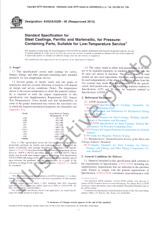We need your consent to use the individual data so that you can see information about your interests, among other things. Click "OK" to give your consent.
ASTM D7980-15(2023)
Standard Guide for Ion-Chromatographic Analysis of Anions in Grab Samples of Ultrapure Water (UPW) in the Semiconductor Industry
Translate name
STANDARD published on 1.4.2023
The information about the standard:
Designation standards: ASTM D7980-15(2023)
Publication date standards: 1.4.2023
SKU: NS-1140874
The number of pages: 3
Approximate weight : 9 g (0.02 lbs)
Country: American technical standard
Category: Technical standards ASTM
The category - similar standards:
Annotation of standard text ASTM D7980-15(2023) :
Keywords:
anions, contamination control, high purity, ion chromatography, trace analysis, ultrapure water,, ICS Number Code 71.060.01 (Inorganic chemicals in general)
Additional information
| Significance and Use | ||||
|
4.1?This guide is intended to help analysts in the semiconductor industry. Examples of the usefulness of anion monitoring include: (4.2?To ensure that the anions are indeed at low-ppt levels, it is recommended to check the conductivity of a subsample before proceeding with Section 5 of this guide. This check does not need to be exact; its purpose is simply to let the analyst know if the conductivity is higher than that of the highest-level standard solution being tested. Any high reading signifies that the sample, if analyzed, might contaminate the instrument. |
||||
| 1. Scope | ||||
|
1.1?This guide applies to ultrapure water that is thought to contain low ppt (parts-per-trillion, weight/weight) levels of anionic contaminants (for example, bromide, chloride, fluoride, nitrate, nitrite, phosphate, and sulfate). To minimize carry-over problems between analyses, it is best to limit the concentration of any one contaminant to approximately 200 ppt (although this limit is only an approximation and may vary, depending on the users application). 1.2?This guide is intended to help analysts avoid contamination of ultrapure-water samples, since contamination control is the primary challenge when quantifying ppt-level anions in grab samples. 1.3?This guide does not include recommendations for collecting samples from the water source. 1.4?This standard does not purport to address all of the safety concerns, if any, associated with its use. It is the responsibility of the user of this standard to establish appropriate safety, health, and environmental practices and determine the applicability of regulatory limitations prior to use. 1.5?This international standard was developed in accordance with internationally recognized principles on standardization established in the Decision on Principles for the Development of International Standards, Guides and Recommendations issued by the World Trade Organization Technical Barriers to Trade (TBT) Committee. |
||||
| 2. Referenced Documents | ||||
|
We recommend:
Technical standards updating
Do you want to make sure you use only the valid technical standards?
We can offer you a solution which will provide you a monthly overview concerning the updating of standards which you use.
Would you like to know more? Look at this page.




 Cookies
Cookies
